denard ea sports cover
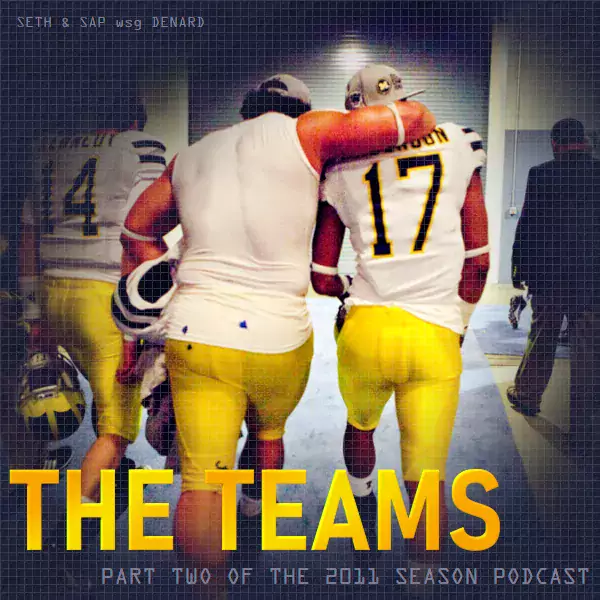

WITH SPECIAL GUEST DENARD ROBINSON. FOR THE WHOLE THING! Big thanks to Bryan Fuller for setting that up. Please listen to Part 1 first if you haven't already.
The Sponsor: If you're buying or reselling, talk to Matt Demorest at HomeSure Lending now and see if you can't lock in a low rate while it lasts. In addition to being more ethical, knowledgeable, hands-on, intelligent, and fun to work with, Matt's cool.
Previously: 1879, 1901, 1918, 1925, 1932, 1940, 1947, 1950, 1964, 1973, 1976, 1980, 1985 p.1& p.2, 1988, 1991, 1999, 2011 p.1
Special Guests: Craig Roh, author of The Pass Rush Bible and Denard Robinson
[Writeup and player after THE JUMP]
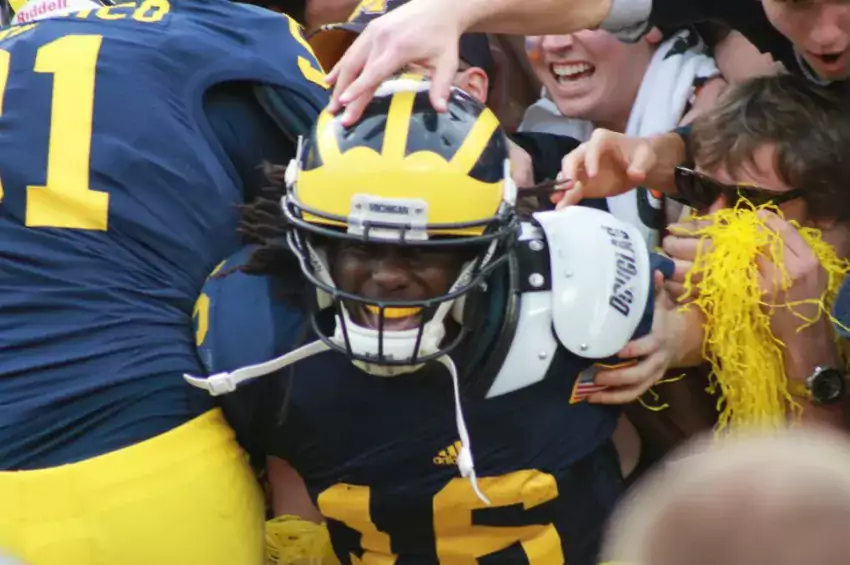
A series covering Michigan's 2010s. Previously: TEs, FBs, and OL, best blocks, the aughts.
Methodology: The staff decided these together and split the writeups. Considering individual years but a player can only be nominated once.
QUARTERBACK
DENARD ROBINSON (2010)
one shining moment [Bryan Fuller]
A decade after the 2010 season, Denard Robinson is still the NCAA Football cover guy. This is in part because the NCAA would rather have no money than share some of it with its players, but it also speaks to the hold Robinson had on college football's imagination. Robinson's career started with a near-literal bang and blossomed into a minor national obsession; it ended with Robinson playing running back in the Outback Bowl because his elbow didn't work anymore.
With some exceptions* NCAA Football cover guys were coming off either legendary team successes (Tim Tebow), legendary individual seasons (Charles Woodson), or both. Denard is the only guy on the cover who ended his final season injury-riddled in a bowl that is so barely New Year's Day that Northwestern's played in it. And when it was announced everyone went "obviously."
That's because Robinson was a video game quarterback brought to life. If you don't know what you're doing you pick the team with the fastest quarterback. You might mistake the snap button for the pitch button on the first snap. Might put the ball on the ground. And then it might not matter at all.
That was Robinson in 2009. In 2010 he won the starting job from Tate Forcier, nuked UConn, and then had one of the greatest individual games in Michigan history against Notre Dame: 24/40 passing, 244 yards, 1 TD, 0 INTs, and 258 yards rushing at 9.2 yards a pop. I am pretty sure the happiest I've ever been after a football game was sitting in the Notre Dame Stadium stands longer than I'd ever sat in the stands before:
When the band marched out, we thought that was our cue. I grabbed one of the souvenir mugs as we exited. When I got home I crudely carved "28-24" on it with a steak knife. It's in the closet. Our walk back was half-accompanied by the band. We met a goodly chunk of my family walking the other way, exchanged excited greetings, and then went about the business of getting out of town. We got to the Chili's just as the adrenaline wore off and the stomach reasserted itself.
A few minutes before everyone filed out Denard Robinson zinged a skinny post to Roy Roundtree on third down and finished the job himself. In the first half Robinson had snuck through a crease in the line, found Patrick Omameh turning Manti Te'o into a safety-destroying weapon, and ran directly at me until he ran out of yards.
He knelt down to give thanks, and that felt inverted.
He broke the NCAA record for rushing yards by a quarterback with 1702 yards at 6.6 YPC(!!!) and completed 63% of his passes for 8.8 YPA, 18 TDs and 11 interceptions. He didn't tie his shoes and he smiled all the time. He showed up to basketball games with Roy Roundtree like he was any other student.
standing in the back next to Roy, Kenny Demens, and JB Fitzgerald [Eric Upchurch]
It didn't last—couldn't last. Rich Rodriguez managed to parlay the #2 S&P offense into a mostly deserved firing, Brady Hoke and Al Borges had no idea what to do with him, and Robinson's ulnar nerve started its slow decline. The "what if Rich Rodriguez didn't have the worst defense in Michigan history at the same time he had Denard Robinson" question is the decade's greatest counterfactual.
There are no other real contenders for this spot. The only other Michigan QB to get drafted this decade was Jake Rudock, who went in the sixth round after a one-year grad-transfer cameo. Shea Patterson does not look set to join them. And there's your decade in a nutshell: the best QB season was the first one, and then pro-style ruined everything.
-Brian
*[There was a two year period where EA had a different cover for every platform they made the game for, which led to guys like Utah QB Brian Johnson and WVU fullback Owen Schmitt on the cover. Most ignominiously of all, the 2009 wii version of the game had Sparty on the cover. The mascot. Also one year they put Boise State QB Jared Zabransky on the cover, presumably for the same reason Gameday occasionally visits Colgate or wherever.]
[After THE JUMP: Okay, we're not writing up this much again. Except maybe for the 4th place receiver as payback for not making him 1st string]
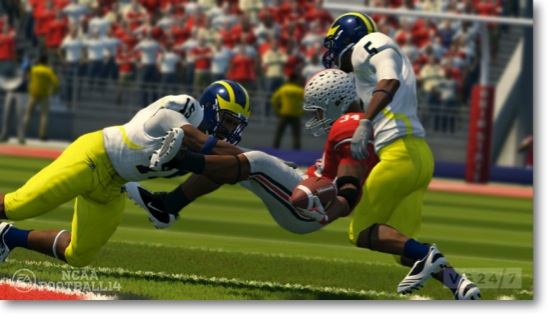
Previously on MGoBlog: Seth's review of the same.
NCAA 14 hits the shelves today, and EA Sports was kind enough to give us an advance copy to review — for the last four days, I've dutifully ignored the lure of sunlight, company, and basic hygiene in order to cram in as many hours as possible with the game. The things I do for you people.
My review of last year's edition eschewed the normal overview of gameplay and the various modes, instead focusing on how to make another underwhelming, mostly-redundant NCAA an enjoyable gaming experience. For the last several years, the basic debate surrounding NCAA has been whether to drop $60 for a couple gameplay tweaks (and, inevitably, a few new gameplay bugs) or save the money and hope for a good roster update.
This year, EA finally made enough changes that it truly feels like a new game in most aspects. Dynasty Mode got a much-needed overhaul, the gameplay adjustments are mostly positive, and the game as a whole feels more realistic. There are gripes, to be sure, but overall I think this is the strongest NCAA in a while.
GAMEPLAY
There have been enough changes to the gameplay (I know, right?) that even experienced players will want some time to learn the new features and hone their skills. Before doing anything else, I'd highly recommend going through the "Nike Skills Trainer"* — a series of tutorials/drills that covers all aspects of the game. Doing those not only helps you get used to some new controls, especially with the overhauled option (more on that later), but the drills are fun on their own — I found myself hitting "try again" several times to see if I could earn a gold medal in each drill, which unlocks a player for the online-only Ultimate Team mode. The skills trainer replaced the mini-games (option dash, tug of war, etc.), which I miss dearly — while the skills trainer is fun, you can't play against anyone else, and the mini-games were great for quick round-robins with a few friends — but it's certainly a worthy addition.
The biggest change once you're ready to hit the field is in the running game, where EA has implemented the physics engine that made last year's Madden so enjoyable. Running looks and feels much more like real life than in the past — setting up blocks is paramount, size matters in collisions, and there's a bevy of new animations that mostly look great (there are still kinks — a few tackles I've seen defied physics). With a good offensive line, running between the tackles can actually be effective.
More importantly, the option — and spread option — has been completely revamped, and I'd guess most players will find that running it in some form is their favorite way to play on offense. The game now helpfully points out the defender to read at the mesh point (for the read option or triple-option dive) or for the pitch (traditional option) before the snap, and variations like the mid-line option and inverted veer are now in the playbook. Backs maintain proper pitch relationship — an issue in years past — and quarterbacks can take hits without consistently getting injured or fumbling (this varies depending on ratings, of course, but QBs used to be outrageously brittle). The CPU can finally run an effective option, as well, with no more inexplicable pitches landing three yards behind the back; defending the option is hard, as it should be.
The passing game is mostly unchanged. Ill-advised throws are going to get picked off more often than not, which is realistic but also tough for gamers who don't know how to read defenses. There are still a few money routes — thank me later for recommending TE Trail in short- to mid-yardage situations — but I've found I can't predetermine where I'm throwing the ball unless the defense is completely misaligned given my playcall. Linebackers no longer are supermen, which helps; I wish receivers would do a better job on their own of adjusting to the ball in the air, though.
Defense is, one again, pretty damn difficult, especially if you want to play in the back seven. CPU quarterbacks are ruthlessly accurate; on All-American difficulty, my best hope of stopping a pass was to blitz and hope for a sack or throwaway, which along with the occasional drop appear to be the only ways to force incompletions. There are little-to-no mistimed routes, passes just out of a receiver's reach, or panicked chucks under pressure; even with a stellar secondary, interceptions and incompletions were very hard to come by, and instead I had to sell out with the pass rush or play conservative zones to keep YAC to a minimum.
Run defense is largely about calling the right play; from there, unless you're quite adept at linebacker or safety, the way your CPU teammates react is the biggest determining factor in a run play's success — this isn't unrealistic, but it doesn't make for a particularly enjoyable defensive experience. I've mostly lined up as a DT and focused on getting a big push into the backfield, which is more fun than it sounds (at least for me) and can have a big effect on both the pass and run games — collapsing the pocket on a QB is by far the most effective way to stop a passing play, as they often slide right into an awaiting DE.
The good news here is that EA now allows you to set separate difficulties for offense and defense. If you find yourself turning the ball over on half your possessions, you can knock the offensive difficulty down a notch; same goes for defense if you can't get a stop. This is an imperfect solution to a major problem — defensive gameplay is still quite frustrating — but it's still appreciated.
DYNASTY MODE
Now here's where things get really fun. Dynasty Mode finally got an overhaul, and it's a good one. First and foremost is the addition of "Coach Skills" — as you progress through your dynasty, you'll earn points for both on-field and recruiting accomplishments, and those points earn upgrades (the details of which can be found here). This adds a RPG-like angle to dynasty that makes it feel like you're really building towards something, not just running through the same season over and over again. You'll have to decide early on if you want to focus on earning in-game boosts (like Coachstradamus, which at its highest level gives you a 25% chance of identifying the opponent's play type before the snap) or an edge in recruiting (Kitchen Sink, for example, raises the cap on points you can spend recruiting individual players). Other coaches earn these same boosts, so you don't just lap the field as your dynasty wears on.
The second major change is the streamlined recruiting process. You get a certain number of points each week to spend on scouting, offering scholarships, and pitching players — those points aren't separate, so you have to find the right balance of scouting and recruiting early on. The critical change is that you don't have to unlock pitches or reset the number of points spent on a recruit each week — you know from day one which pitches a recruit likes and how many bonus points you'll get each week from them, then choose how many additional points to add from your pool. Those points don't change from week to week unless you change them; if you want, you can set your board in Week 1 and then forget about it (though I wouldn't recommend it). Even if you decide to spend time recruiting each week, the process goes much faster — including in the offseason, where the recruiting process has been cut down from a bloated five-week ordeal into a one-shot bidding war (you get a pool of 10,000 points and all caps for individual player spending go away).
The points system adds much more clarity to recruiting; you know exactly how far ahead or behind you are with a recruit, the bonus points your competition is getting each week, and the baseline number of points you'll earn on a given visit. This allows you to be much more strategic when it comes to targeting recruits, especially the longshots. With the roster cap still at 75 (ugh) and yearly scholarship caps at 25, I've found that narrowing down my recruiting board early and bringing in classes of 15-20 recruits gives me the best chance at landing a top class. Other recruiting tips:
- If you can, max out the Scouting coach skill as quickly as possible. There are plenty of "gems" and "busts" in the prospect field, and identifying those guys early is an easy way to cut down your board and focus on the best prospects. This is especially useful in preseason, when you get 1,000 points to spend solely on scouting.
- DO THE MATH. You can figure out precisely how many points you need to give a recruit based on the bonus points other teams are receiving and the weekly changes on a prospect's top schools board. Sometimes, even if you max out a recruit's weekly points, it's impossible for you to catch another program (usually Alabama). Drop those recruits like they're hot.
- After a certain amount of time, a recruit "locks" into a certain number of schools, and the rest are eliminated from contention — the numbers of schools locked in and how early this happens depends on the recruit. It's worth searching the board on occasion for prospects who are still <25% locked in the latter half of the season; even if the prospect doesn't have initial interest, you can often swoop in and pick these guys up late. This is a great fallback if you miss out on a prospect at a position of need.
- Pay attention to pipelines. Having a certain number of prospects from a specific state makes that state a pipeline, and you earn bonus points with a prospect if they hail from that state. Again, it's all about maximizing your limited number of points, so any edge you can find is helpful.
- The game gives extra points for scheduling visits late in the season — your goal with most prospects should be to get their final visit, and the game encourages you to schedule everyone as late as possible. DON'T ALWAYS DO THIS. Visits can cause huge swings in points, so if you have a comfortable lead for a prospect early, bring them in ASAP and you'll probably lock everyone else out and earn his commitment. Scheduling an early visit can also save you from being locked out, though you'll then have to sweat out the recruit's subsequent visits.
Other than recruiting and coach skills, dynasty mode is mostly the same, which is good — that's always been my go-to mode. My biggest gripe is that there is no playoff starting in 2014 — you're stuck with the BCS in perpetuity, which is especially unfortunate since the game occasionally produces some wonky title games. Exempli gratia:

Even worse: Stanford beat Washington by 30 in their simulated matchup.
EA is probably waiting to unveil the playoff (sorry: cofopoff) as a new "feature" in next year's game. This is pretty lame, EA.
Overall, though, the changes to dynasty mode are a big step in the right direction, making an already enjoyable game mode even better. My only gripe with the coach skills is they can sometimes make things too easy — if Coachstradamus tells me the defense is in a Cover 2, I know enough to audible to a play that will gain 15 yards at worst — but you can set how difficult it is to level up, which helps mitigate that issue. The RPG aspect is something I very much enjoy; I found myself tempted to race through seasons so I could pick up more bonuses and build a true juggernaut.
OTHER GAME MODES
Road To Glory — in which you take a player from high school recruit through his college career — is still in the game and, as EA admitted, is essentially untouched. If you liked the mode in years past, you'll still enjoy it. If you didn't — or found it less compelling than Dynasty Mode — then it's not worth trying again.
EA imported their popular Ultimate Team feature — in which you unlock players through in-game accomplishments, then use them in games against online opponents — to NCAA. You can use these players, which include several all-time greats and (until yesterday) one "oh shit, get him out of here", in head-to-head online seasons or solo challenges. I haven't had the chance to delve into this mode in depth, so I won't comment on its merits except to say that it'd be nice if there was an offline option.
If you're the type who just wants to play the game but still want to play for something, there's a new "2013 Season" mode, which is exactly what it sounds like — you play (or sim, though that seems to defeat the purpose) your way through the 2013 season without having to worry about recruiting and the like. This won't be a feature I use but I'm sure some of you will appreciate it.
GRAPHICS/SOUND
It's pretty clear at this stage that EA has maxed out what they can do on the PS3 (oh, hey, just in time for the PS4!). There are some minor graphics improvements — players' muscles are more defined, for one — but the atmosphere falls flat at times; players on the sideline look like they're imported from a PS2, the field and crowd often look flat and dull. This isn't a big deal for me as much as the actual gameplay, especially since it's clear that EA has to hold back on minute details to ensure the game runs smoothy (and I'll take that over picture-perfect fieldturf).
In a long-overdue move, NCAA has new in-game camera angles, including a wide-angle view that allows you to see all 22 players on the field. I haven't toyed around with them much — on the first try, I found the wide angle to be a little too zoomed out — but at least there are options now.
As for the sound, you're still getting the same generic commentary in games, and the same repetitive marching band music in the menus (my first move is always to turn off the menu music and sound FX so I can listen to whatever I want while moving through my dynasty). EA has tried to add to the atmosphere by including piped-in music — yes, "Seven Nation Army" is in the game — which you'll either slightly appreciate or hate with the fury of a thousand suns. (Hi, Brian.)
BUGS
Aside from the BCS tomfoolery, I've found the game pleasantly devoid of glitches or major issues with simulation. The only real glitch I noticed occurred once, when my CPU opponent went into the hurry-up and, with the rest of the offense set, the center stood over the ball until the play clock ran out. That hasn't happened since and the CPU loves to run the hurry-up, so that's hopefully an easy fix when EA releases the inevitable patch.
This isn't a bug, but a new recruiting feature is "complimentary" visits — no, this doesn't mean your coach heaps an excessive amount of flattery on a recruit, but instead that the player is visiting along with recruits of compatible positions (e.g. having a QB and WR visit in the same week). As a writer, or at least a person with a decent command of the English language, this drives me nuts.
OVERALL
This is my favorite edition of NCAA since they moved to the PS3. The run game is a lot of fun, especially the option, and unlike many I think the passing game is enjoyably challenging. Defense still needs plenty of work, especially in defending CPU quarterbacks, but I'm holding out hope that messing with the sliders — or perhaps a major patch — will alleviate some of the issues. (I didn't touch the sliders for this review so I could give a fair impression of the game right out of the box; if you're a serious gamer, I highly recommend checking the Operation Sports forums for tips on setting sliders.) With the improvements to Dynasty Mode, this is the first time in a while I've felt confident in saying a new edition of NCAA is worth the price tag.
Now if EA could just add the playoff and bring back the mini-games, baby, we'd really have a stew goin'.
------------
*Product placement and ads for in-game extras are both quite prevalent. I found this fairly annoying — and I'm sure Ed O'Bannon does, too — especially when it comes to EA suggesting you purchase booster packs for a game that already costs $60. Long live capitalism, I guess.
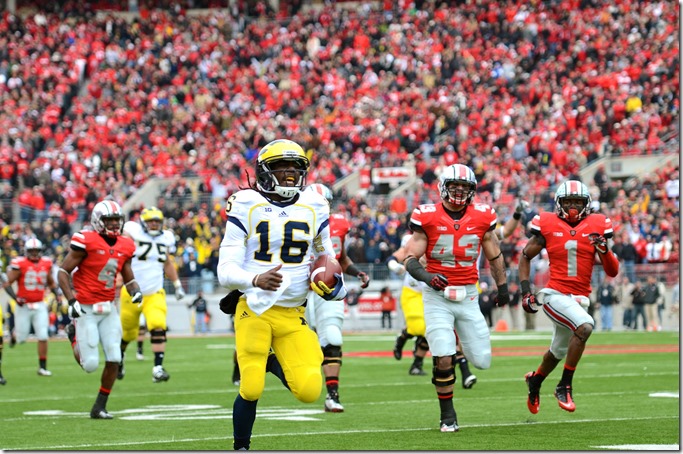
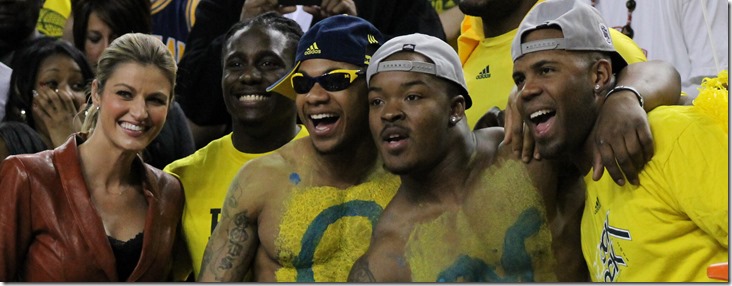
4